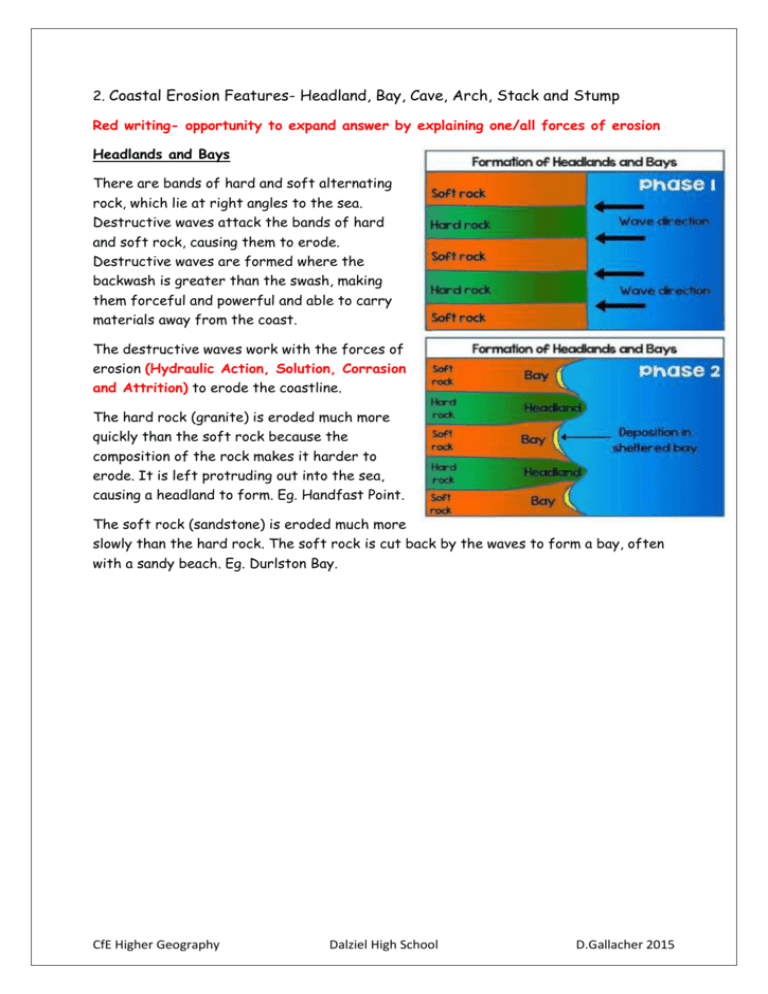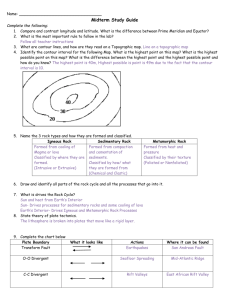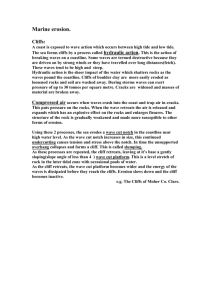2. Coastal Erosion Features MrG.
advertisement

2. Coastal Erosion Features- Headland, Bay, Cave, Arch, Stack and Stump Red writing- opportunity to expand answer by explaining one/all forces of erosion Headlands and Bays There are bands of hard and soft alternating rock, which lie at right angles to the sea. Destructive waves attack the bands of hard and soft rock, causing them to erode. Destructive waves are formed where the backwash is greater than the swash, making them forceful and powerful and able to carry materials away from the coast. The destructive waves work with the forces of erosion (Hydraulic Action, Solution, Corrasion and Attrition) to erode the coastline. The hard rock (granite) is eroded much more quickly than the soft rock because the composition of the rock makes it harder to erode. It is left protruding out into the sea, causing a headland to form. Eg. Handfast Point. The soft rock (sandstone) is eroded much more slowly than the hard rock. The soft rock is cut back by the waves to form a bay, often with a sandy beach. Eg. Durlston Bay. CfE Higher Geography Dalziel High School D.Gallacher 2015 Caves and Arches, Stacks and Stumps The headland is left protruding out into the sea and is continuously attacked by the destructive waves. Destructive waves are formed where the backwash is greater than the swash, making them forceful and powerful and able to carry materials away from the coast. The destructive waves work with the forces of erosion to erode the protruding headland. 1.Hydraulic Action attacks weaknesses in the headland like joints or faults. The force of the water pressurizing the weaknesses makes them wider and deeper causing a crack to form. 2.Solution attacks the crack, the salts or acids in the water chemically react with the rock and dissolve it. This makes the crack become wider and wider over time, eventually giving way to form a cave. Eg. Tillywhim caves. 3. Often, two cave are formed back to back. The process of corrasion (the sea propelling rocks using the wave power against the headland causing vibrations and fractures in the rock) deepens the two caves, until they meet in the middle, causing and arch to form. Eg. Durdle Door. 4.The arch is attacked by the force of the waves and becomes wider and wider. As this happens, the roof becomes unsupported, cracks grow and the rock fractures. The roof then collapses and falls into the sea. The pillar of rock is left standing alone in the sea called a stack. Eg. Old Harry 5. The stack is continuously attacked by the force of the waves. The waves attack the base and a wave cut notch is formed in the stack. This causes it to get weaker and weaker. The rock above the wave cut notch cannot be supported and falls into the sea, creating a stump. Eg. Old Harry’s wife CfE Higher Geography Dalziel High School D.Gallacher 2015






